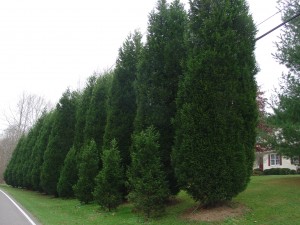Leyland cypress (xCupressocyparis x leylandii) is winter hardy in the Southern Appalachian region (USDA zones 6 and 7). It is frequently regarded as “the” conifer for Southern states. Its growth rate, compared to other evergreen conifers, is horrendously fast, with young established plants growing 3 feet or more annually. A young 2-3 foot specimen may reach 25 to 30 feet tall in only ten years. A 50 to 60 foot tall Leyland screen is a common sight.
At planting time Leyland should be spaced 16 to 18 feet apart and no closer. An alternative design is to plant each 8 foot apart and eliminate (or transplant) every other Leyland within 3-4 years.
Plant Leyland in full day sun and in fertile well-drained soil. A new planting should start off irrigated the first two summers. Backup irrigation during severe summer dry periods is highly advised to prevent disease flareups.
What attracts gardeners to plant Leylands is the soft green sprays of evergreen foliage. Numerous cultivars are available, and three commonly planted include: ‘Haggerston Grey’ (green needles with slight gray cast), ‘Leighton Green’ (rich green), and ‘Gold Rider’ (yellow with green tips).
Crowded and/or shaded plants are susceptible to any of three serious fungal diseases: Cercospora needle blight, Botryosphaeria canker, and Seiridium canker. Occasionally, bagworms populations may ravage Leyland foliage in late spring. Fungicide and pest spraying are mostly ineffective due to the enormous size of Leyland cypress.
Leyland is now commercially grown as a Christmas tree in the deep South, where fraser fir trees do not thrive. Leyland’s foliage displays exceptional sea salt tolerance, making it a good wind barrier around coastal areas.


 Posted in
Posted in 
